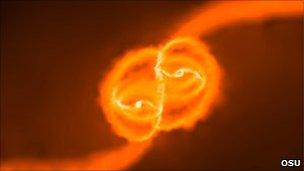Supercomputer clue to black holes
- Published

The supercomputer simulates how gas behaves when two galaxies merge
The colossal black holes at the centre of galaxies probably formed shortly after the Big Bang, a study suggests.
Some of these behemoths are billions of times more massive than our Sun.
Supercomputer simulations indicate the conditions for the birth and growth of these giants could have been set in play by the merger of galaxies when the cosmos was just a few hundred million years old.
The research, by Lucio Mayer and colleagues, is published in Nature.
The team's modelling found that the collision and union of two early galaxies could produce an enormous disc of rotating gas, and that this disc could become unstable and fall in on itself in rapid time.
The simulation showed gas with a mass equivalent to hundreds of millions of Suns accumulating in a small region of space in just a few thousand years after the merger.
And the properties of this cloud meant it could gravitationally collapse at high speed into a black hole, perhaps directly without going through any transient phase in which a star is formed first - the familiar route.
Even a "seed" hole of a few hundred million solar masses could then go on to become a billion-solar-mass hole in very short order by continuing to accumulate gas, the modelling found.
Today, enormous black holes seem to lie at the centre of most large galaxies. Although these objects cannot be seen directly, their existence is betrayed by nearby stars whose high velocities can only be explained if they are being pulled along by something with an immense gravitational attraction.
Understanding how these supermassive black holes came into being and how they evolved is a major question in astrophysics.
"There is an amazing correlation between black holes and their galaxies," observed Professor Marta Volonteri from the University of Michigan.
"Every time you look in a galaxy for a [supermassive] black hole, you find it; and the mass of the black hole is typically a 1,000 times less than the mass of the galaxy.
"How has such a great correlation been established? How is it possible they knew so well about each other throughout these past 13 billion years? So, we really want to know how the black holes started and how they grew with time," she told BBC News.
Professor Volonteri was not part of the team which did the modelling but the originator of the theory tested in the Nature-published research.
Professor Mayer said the new study had major consequences for the apparent size relationship between supermassive black holes and their host galaxies.
It challenged the idea galaxies grew in a hierarchical fashion, in incremental steps in which gravity pulls small masses together to form progressively larger structures, University of Zurich scientist added.
"If we are right, one expects that [in the early Universe] there will be no clear relation as in the present-day Universe, since the black holes would be already very massive (because they form in only a few hundred thousand years after galaxy collisions) while the galaxies still have to grow a lot until the present time.
"New data are beginning to show that maybe this is what is happening," Professor Mayer told BBC News.
"This, of course, would distinguish our model from the old one in which small seed black holes are formed first from the collapse of primordial stars and then slowly grow to the present sizes. (In this case, galaxies and massive black holes grow in parallel; while in our case, black holes grow much faster than galaxies.)"
- Published8 July 2010
- Published12 May 2010